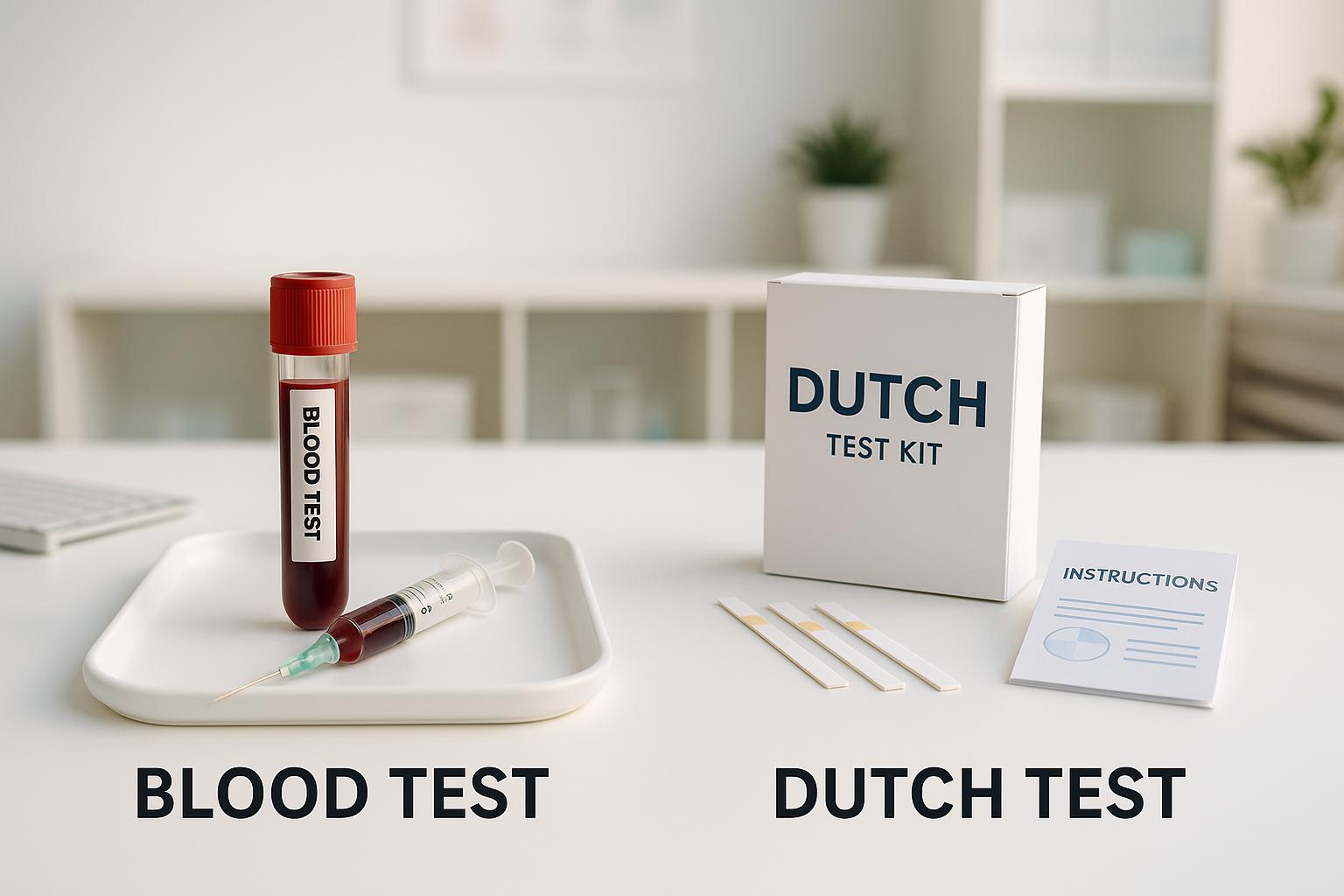Hormone testing is essential for diagnosing and managing imbalances that can cause symptoms like fatigue, mood swings, and irregular periods. The two primary methods – DUTCH Test and Blood Test – serve different purposes. Here’s a quick breakdown:
- DUTCH Test: At-home urine collection over 24 hours provides a detailed view of hormone fluctuations and metabolism. Best for complex cases like fertility issues, PCOS, or chronic fatigue.
- Blood Test: A single blood draw at a clinic offers a snapshot of hormone levels. Ideal for quick results, thyroid issues, or tracking treatment progress.
Quick Comparison:
| Feature | DUTCH Test | Blood Test |
|---|---|---|
| Sample Collection | At-home urine samples | In-clinic blood draw |
| Timeframe | Measures 24-hour hormone patterns | Single-point measurement |
| Hormones Analyzed | Sex, adrenal hormones, metabolites | Circulating hormones |
| Best For | Complex, long-term hormone issues | Acute or specific conditions |
| Convenience | High (at-home collection) | Lower (clinic visit required) |
Both tests are accurate within their scope. Choosing the right one depends on your symptoms and health goals. For a deeper dive into hormone metabolism, the DUTCH Test is a great choice, while Blood Tests are better for immediate diagnostics.
How does DUTCH hormone testing compare to blood testing?
What Is the DUTCH Test

The DUTCH Test, short for Dried Urine Test for Comprehensive Hormones, uses dried urine samples collected at home to measure over 30 hormones and 35 metabolites. This method offers a more dynamic hormone profile compared to single-point blood tests. To perform the test, you collect urine samples on absorbent paper. These samples are then analyzed, with adjustments made for urine concentration, providing a detailed look at hormone levels and their breakdown products.
Steroid hormones in your body are processed into water-soluble metabolites, which are excreted in urine. By measuring 35 hormone metabolites, the DUTCH Test evaluates how effectively your body processes hormones rather than simply measuring static levels. One of its standout features is the cortisol curve, which involves collecting 4 to 5 samples within a 24-hour period. This allows for a detailed view of how cortisol levels fluctuate throughout the day.
"The DUTCH Test allows me to help my patients see meaningful differentiation in their results, which helps me create even better treatment plans." – Carrie Jones, ND, FABNE, MPH
For women with regular menstrual cycles, timing is crucial when taking the DUTCH Test. Women with a 28-day cycle are generally advised to test on Days 19, 20, or 21 (with Day 1 being the first day of menstrual flow). For those on hormonal birth control, it’s recommended to wait until stopping contraception and allowing at least three cycles to pass before testing.
Hormones Measured by the DUTCH Test
The DUTCH Test provides a thorough analysis of hormone health by measuring sex hormones (like estrogen, progesterone, and testosterone) and adrenal hormones (such as cortisol and DHEA), along with their metabolites. In total, it evaluates 35 hormones, including estrogen, progesterone, testosterone, DHEA-S, and cortisol, as well as their breakdown products. By analyzing these metabolites, the test highlights how efficiently your body produces, uses, and clears hormones. It also uncovers daily patterns, showing how hormone fluctuations may be affecting your health and symptoms.
This test is particularly useful for understanding sex and adrenal hormone production, diurnal cortisol and cortisone patterns, melatonin levels, and micronutrient availability. It’s often used to investigate hormonal influences on conditions like perimenopause, menopause, weight changes, low libido, fertility challenges, PCOS, mood disorders, and sleep issues.
Benefits of the DUTCH Test
What makes the DUTCH Test stand out is its ability to provide a detailed, 24-hour analysis of hormone fluctuations – all from the comfort of your home. This eliminates the need for multiple clinic visits, which can reduce stress and lead to more accurate results. Unlike standard blood or saliva tests that often provide a single number or range, the DUTCH Test delivers highly detailed insights. By identifying the underlying causes of hormone imbalances through metabolite analysis, healthcare providers can develop more personalized and effective treatment plans.
The test also takes a deeper dive into hormone health by assessing metabolites, which are the byproducts of hormone breakdown. This approach offers a broader understanding of your hormonal state.
"Every one of my clients gets a DUTCH Complete™. It’s a great system of checks and balances. I don’t ever send someone out to get hormones until I do a DUTCH Test." – Esther Blum, MS, RD, CDN, CNS
For practitioners, the DUTCH Test provides a comprehensive view of hormone levels and metabolism, often helping to unravel complex clinical cases. It’s especially valuable for individuals with unexplained symptoms or those who haven’t found answers through traditional testing methods.
How Blood Tests Work for Hormones
Blood tests analyze hormone levels by examining a sample drawn in a clinical setting. This method has been a cornerstone of hormone testing for over 40 years, with immunoassays being a primary tool during that time. The process involves taking blood – typically from a vein in your arm – and sending it to a lab for detailed analysis.
Timing plays a crucial role in obtaining accurate results. Blood samples are often collected in the morning when hormone levels are at their highest. For instance, testosterone levels in men peak in the early hours, while in women, hormone levels vary depending on the menstrual cycle phase. This single-point measurement gives a snapshot of your hormone levels at that specific time, making timing an important consideration for interpreting results.
Blood tests are considered the gold standard for measuring hormone concentrations directly from the bloodstream. Over time, testing methods have advanced significantly, moving from basic biological assays to modern immunoassays. Tandem mass spectrometry (TMS) has now become a preferred method for its precision and accuracy.
Hormones Measured by Blood Tests
Blood tests can measure a wide array of hormones, including testosterone, estrogen, cortisol, and thyroid hormones. The selection of hormones tested depends on your symptoms and what your healthcare provider suspects may be contributing to your condition.
Some commonly assessed hormones include thyroid-stimulating hormone (TSH), testosterone (in its various forms), estrogen, progesterone, cortisol, and insulin. For testosterone, tests can measure total testosterone, free testosterone, or bioavailable testosterone, each offering unique insights into hormonal health.
| Hormone | What High Levels May Indicate | What Low Levels May Indicate |
|---|---|---|
| TSH (Thyroid-Stimulating Hormone) | Hypothyroidism | Hyperthyroidism |
| Estrogen | Estrogen dominance or certain cancers | Menopause or ovarian failure |
| Progesterone | Varies by cycle phase | Issues with ovulation or miscarriage risk |
| Testosterone | PCOS in women | Hypogonadism in men |
| Cortisol | Stress or Cushing’s syndrome | Addison’s disease |
| Insulin | Insulin resistance or type 2 diabetes | Hypoglycemia or issues with insulin production |
These measurements play a critical role in diagnosing and managing conditions like thyroid disorders, diabetes, and reproductive health issues. To put it into perspective, thyroid disorders affect about 20 million Americans, diabetes impacts nearly 38.4 million people, and infertility is a challenge for 11% of women and 9% of men of reproductive age.
Benefits of Blood Tests
Blood tests offer several advantages for evaluating hormone levels. They provide detailed insights into specific hormones, helping healthcare providers make accurate diagnoses. This precision allows doctors to determine whether your hormones fall within a healthy range and to track treatment effectiveness.
"You shouldn’t ignore symptoms related to hormonal imbalance, but we don’t do hormone testing without good reason."
- Dr. Shamita Misra, Family Medicine Doctor at MU Health Care
Another advantage is safety monitoring. Blood tests can reveal whether your medication needs adjusting, which is especially important during hormone therapy. Additionally, they deliver relatively quick results in urgent situations, enabling timely decisions when hormone imbalances require immediate attention.
Despite these benefits, blood tests have limitations. They only capture a snapshot of hormone levels at the time of the test, which may not reflect daily fluctuations. They also might not fully show how hormones are metabolized or processed by the body. Furthermore, the procedure can feel invasive or stressful compared to more convenient at-home testing options.
For the most accurate results, it’s essential to share all symptoms with your healthcare provider to guide the testing process. If abnormal cortisol or ACTH levels are detected, whether high or low, follow-up with your doctor is a critical next step.
sbb-itb-d9e542d
DUTCH Test vs. Blood Test Comparison
Understanding the differences between the DUTCH test and blood tests is key to making informed decisions about your hormone health. While both methods measure hormone levels, they differ in how samples are collected and the type of information they provide.
The main distinction lies in sample collection. Blood tests require an in-clinic blood draw, while the DUTCH test uses dried urine samples collected at home throughout the day. This at-home method is not only more convenient but also impacts the kind of data the test can offer. This difference sets the stage for a more detailed comparison of the insights each method provides.
Blood tests offer a snapshot of hormone levels at the moment of collection, making them useful for immediate diagnosis. However, they often miss fluctuations that occur throughout the day. In contrast, the DUTCH test measures hormone production and metabolites over a 24-hour period, providing a more comprehensive view of hormonal patterns that a single blood draw might overlook.
"While traditional hormone diagnostics provide limited information about hormonal status, the DUTCH Test provides practitioners with a complete picture of patient hormone levels and metabolism to help solve complex clinical questions with easy at-home collection."
The scope of information also varies significantly. Blood tests focus on measuring hormone levels circulating in the bloodstream at a specific moment, while the DUTCH test goes further by analyzing hormone metabolites in urine.
For instance, if you’re experiencing estrogen-related issues, a blood test might show normal estrogen levels. However, the DUTCH test could reveal that your body isn’t breaking down estrogen effectively, shedding light on persistent symptoms that might otherwise be unexplained. This metabolic insight is particularly useful because urine contains about 1,000 times more estradiol than saliva, offering a clearer picture of estrogen metabolism.
Side-by-Side Comparison
| Feature | DUTCH Test | Blood Test |
|---|---|---|
| Sample Collection | At-home dried urine samples | Blood draw at a medical facility |
| Information Provided | Hormone production and metabolism over 24 hours | Hormone levels at a single point in time |
| Hormones Measured | Sex hormones, adrenal hormones, metabolites, organic acids | Specific hormones circulating in the bloodstream |
| Convenience | High (collect at home on your schedule) | Lower convenience due to in-clinic collection |
| Daily Patterns | Captures hormonal fluctuations throughout the day | Provides only a single snapshot |
| Metabolic Insights | Shows how the body processes hormones | Limited information on metabolism |
| Clinical Status | Valuable tool in functional medicine | Considered the "gold standard" |
| Best For | Root cause analysis and comprehensive assessment | Quick diagnosis and immediate hormone level measurement |
Blood tests are ideal when healthcare providers need precise, real-time measurements of specific hormones, such as in cases of thyroid disorders. Meanwhile, the DUTCH test excels in functional medicine, offering a full hormone profile that’s critical for analyzing complex conditions.
This broader approach is especially helpful for conditions like chronic fatigue. Studies show that cortisol levels measured through traditional tests failed to correlate with 50%–80% of patients’ chronic fatigue symptoms in a comprehensive analysis. The DUTCH test, which measures both free and metabolized cortisol along with daily patterns, can identify adrenal fatigue or chronic stress that single-point blood tests might miss.
While both tests are accurate within their scope, blood tests are the go-to for precise measurements of circulating hormones and are often considered the standard for establishing baseline levels. However, they may not provide a complete view of hormonal health, especially for conditions tied to metabolism or daily fluctuations.
Cost and accessibility also vary. Blood tests often require insurance pre-authorization and multiple clinic visits for follow-ups. On the other hand, DUTCH tests involve upfront costs but allow for at-home sample collection and a detailed analysis in one exam.
Choosing the right test depends on your specific needs and treatment goals. Neither test is inherently superior – they each serve distinct purposes in assessing hormone health.
When to Use Each Test
Choosing the right hormone test depends on whether you’re after a detailed metabolic overview or need quick, targeted results.
Best Times to Choose the DUTCH Test
The DUTCH test is ideal for addressing complex hormone-related conditions. It provides a deep dive into how your body produces and processes hormones.
One of its standout applications is in fertility and reproductive health. The test helps uncover hormonal imbalances that could affect conception and sheds light on menstrual irregularities.
For those dealing with PCOS symptoms, such as acne, hair thinning, or excessive hair growth, the DUTCH test offers a thorough analysis of female sex hormones and androgens.
It’s also a valuable tool for monitoring perimenopause and menopause, as it tracks hormonal fluctuations over time, making it easier to understand changes during these life stages.
If you’re experiencing symptoms of estrogen dominance – like mood swings, fibrocystic breasts, or severe PMS – the DUTCH test evaluates whether estrogen levels are out of balance and how efficiently your body metabolizes and eliminates estrogen.
The test also excels in assessing adrenal function, measuring cortisol and its metabolites. This can provide deeper insights for those feeling chronically stressed or fatigued, going beyond what a standard cortisol blood test can reveal.
For sleep issues, the DUTCH test examines melatonin levels and circadian rhythms, helping to pinpoint hormonal causes of sleep disturbances.
Additionally, it’s useful for hormone replacement therapy (HRT) monitoring, as it not only measures hormone levels but also evaluates how well your body processes supplemented hormones. This can help fine-tune treatments, especially when hormonal imbalances are linked to weight loss resistance.
Kristen B, a patient, shared her experience with the DUTCH test:
"I will probably have a DUTCH Test once a year for as long as I’m alive, because I feel like I get a really good launching pad just to help me be the healthiest version of myself."
For scenarios requiring immediate and precise results, however, blood tests might be the better choice.
Best Times to Choose Blood Tests
Blood tests are designed for quick, accurate snapshots of hormone levels in your bloodstream, making them ideal for certain situations.
They’re the go-to option for diagnosing thyroid disorders, offering standardized measurements of TSH, T3, and T4 that guide treatment decisions.
If you’re dealing with acute hormone imbalances and need fast answers, blood tests provide rapid results, often with the added benefit of being covered by insurance.
Blood tests are also helpful for establishing baseline hormone levels, ensuring consistency when tracking treatment progress.
In cases where specific hormone confirmation is needed, blood tests shine. For example, if the DUTCH test suggests low testosterone, a blood test can confirm the result, especially when genetic factors might play a role in hormone metabolism.
Combining both tests can offer a more complete picture. For instance, pairing a full thyroid panel with the DUTCH test can help determine if a hormonal imbalance is linked to thyroid issues, whether subtle or more pronounced. The best approach is to collaborate with a healthcare provider who specializes in hormones. They can guide you in selecting the right tests based on your symptoms, medical history, and treatment goals.
Conclusion
The DUTCH test and blood tests each serve distinct but equally important roles in evaluating hormone health. The DUTCH test provides an in-depth look at hormone metabolism over a 24-hour period, offering detailed insights that can be especially useful for complex conditions like PCOS, estrogen dominance, or chronic fatigue. These insights help uncover the underlying metabolic processes that might be contributing to symptoms.
On the other hand, blood tests offer quick and standardized snapshots of hormone levels at a given moment. They are particularly suited for diagnosing acute issues like thyroid disorders, establishing baseline levels, or situations where fast results are essential. Their accessibility and insurance coverage also make them a practical choice for routine monitoring.
Instead of viewing these tests as competing options, many healthcare providers use them together to create a more complete picture. For instance, while a blood test might confirm low testosterone levels, a DUTCH test can reveal why the body struggles with hormone metabolism. Combining these methods allows for a more thorough understanding of hormonal health.
If you’re dealing with ongoing, unresolved symptoms, the DUTCH test’s ability to dive deeper into hormone metabolism could provide the answers you’ve been searching for. For simpler monitoring or acute concerns, blood tests remain a reliable option.
At Kinnection Clinic, we believe in tailoring testing strategies to the individual. By integrating both approaches, we aim to identify the root causes of hormonal imbalances rather than just addressing surface-level symptoms. Our team works with you to develop a personalized testing and treatment plan that aligns with your health goals, helping you take meaningful steps toward achieving hormonal balance and overall wellness.
FAQs
What’s the difference between the DUTCH Test and a blood test for hormone health, and when should you use each one?
The DUTCH Test offers a deep dive into hormone health by analyzing hormones such as cortisol, melatonin, progesterone, estrogens, and androgens through urine samples. What sets this test apart is its ability to track hormone metabolism and daily fluctuations, making it particularly helpful for identifying concerns like hormonal imbalances, chronic stress, or PMS.
On the other hand, blood tests provide a snapshot of hormone levels at a single point in time. These are commonly used to diagnose conditions like low testosterone, thyroid issues, or fertility challenges. Blood tests are ideal for quick, real-time assessments, whereas the DUTCH Test provides a broader, more detailed picture of your hormonal landscape.
Depending on your health goals, these two tests can work together to provide a well-rounded understanding of your hormone health.
What makes the DUTCH Test more insightful for hormone metabolism than a standard blood test?
The DUTCH Test provides a more detailed look at hormone metabolism by measuring not just hormone levels, but also their metabolites. This helps uncover how your body processes and uses hormones – offering insights that standard blood tests might overlook, like patterns in hormone production and breakdown.
Unlike traditional blood tests that capture hormone levels at a single moment, the DUTCH Test tracks hormone activity throughout an entire day. This makes it especially useful for evaluating cortisol rhythms and overall hormonal balance, giving you a broader and more accurate view of your health.
Can combining the DUTCH test and blood test provide a more complete picture of hormone health?
Yes, combining the DUTCH test with a blood test can provide a broader picture of your hormone health. The DUTCH test focuses on how your body processes hormones over time, offering detailed information about adrenal function and sex hormone balance. Meanwhile, blood tests measure hormone levels at a single moment, making them especially helpful for evaluating hormones like testosterone and estrogen.
Using both tests together allows you to better understand your hormone production, how they’re metabolized, and whether they’re in balance. This well-rounded approach can help create more tailored treatment plans based on your specific needs.



